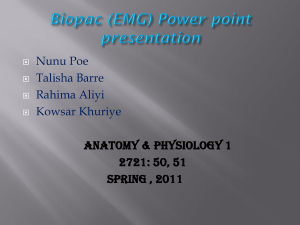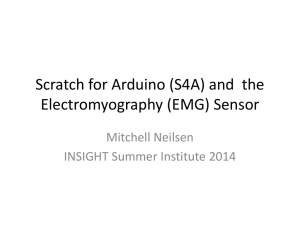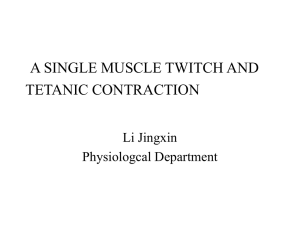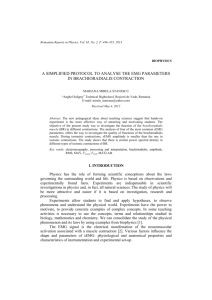Lecture 12 Electromyography
advertisement
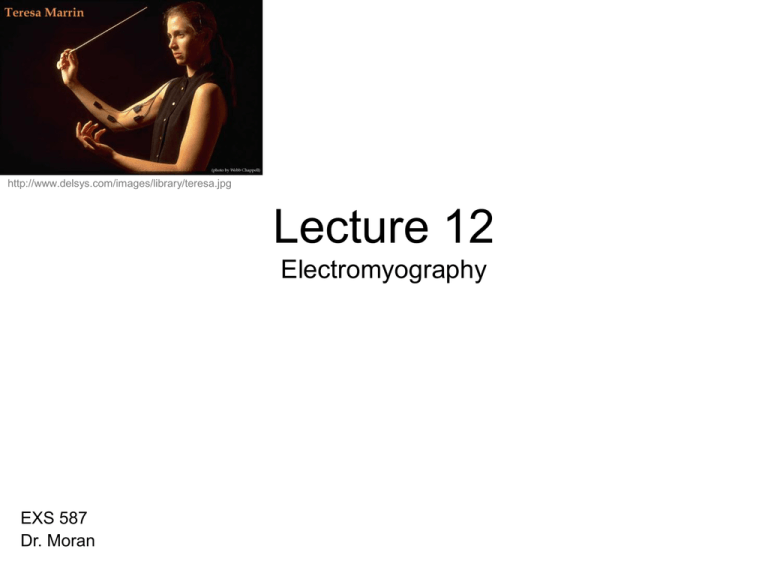
http://www.delsys.com/images/library/teresa.jpg Lecture 12 Electromyography EXS 587 Dr. Moran Outline • Finish Lecture 11 (Muscle Moment – Moment Arm) • Review of Muscle Contraction Physiology • Physiological Basis and Concepts of EMG (Alwin Luttmann) • Methods of EMG Collection • Electromyograhy in Ergonomics (Shrawan Kumar) • Limitations & Uses • Journal of Electromyography and Kinesiology (full-text in ScienceDirect) Physiological Basis • Muscle contraction due to a change in the relative sliding of thread-like molecules or filaments • Actin and Myosin • Filament sliding triggered by electrical phenomenon (ACTION POTENTIAL, AP) • The recording of muscle APs is called electromyography • The record is known as an electromyogram What can be learned from an EMG? • Time course of muscle contraction • Contraction force • Coordination of several muscles in a movement sequence • These parameters are DERIVED from the amplitude, frequency, and change of these over time of the EMG signal • Field of Ergonomics: from the EMG conclusions about muscle strain and the occurrence of muscular fatigue can be derived as well Excitable Membranes • Cell membrane separates intracellular from extracellular space • Diffusion barrier which restricts ION flow • Cell Membrane Structure – Double layer of phospholipids (both surfaces covered in proteins) • • Hydrophyllic Head Hydrophobic Tail – Role of Proteins • Transport – “carrier molecules” • Receptor – Transfer information http://www.longevity.ca/images/cell_membrane3.gif Fluid Distribution • Concentration of ions different inside vs. outside of cell membrane • This results in an electrical potential difference known as a MEMBRANE POTENTIAL • Typical magnitude of membrane potential is -60 and 90 mV (interior of cell is negatively charged) • This potential can change within fractions of seconds to +20 to +50 mV • This rapid change is called an ACTION POTENTIAL Ion Concentration • Intracellular Fluid • High concentration of Potassium cations (K+) and Protein anions (A-) • Extracellular Space • High concentrations of Sodium cations (Na+) and chloride anions (Cl-) Ions [Intracellular] mmol/l [Extracellular] mmol/l Ratio: Inside/outside Na+ 12 145 1:12 K+ 155 4 40:1 Cl- 4 120 1:30 A- 155 --- --- Uneven distribution the work of active transport that pushes Na+ from inside to outside and K+ from outside to inside (ION PUMP, requires ATP) - + FCON FEL INSIDE High [K+] OUTSIDE CELL MEMBRANE (permeable to K+) Low [K+] Nernst Equation • Used to determine resting membrane potential RT » Vm = z F ln (ci/co) • Nernst Extension (Goldman 1943): considered the effect of only K+, Na+, and Cl• Based on their permeabilities and [ ] values in preceding slide the resting membrane potential is -75 mV Action Potential • Active response of excitable membranes in nerve and muscle fibers produced by sodium and potassium channels opening in response to a stimulus • AP abide by the all-or-none principle • If MP reaches threshold voltage then Na+ channels open at first (Which direction will Na+ flow?) • Na+ channels only open for 1 ms, this causes repolarization (K+ channels also open during this time to speed up return of resting membrane potential) Action Potential (continued) http://upload.wikimedia.org/wikipedia/en/thumb/7/78/Apshoot.jpg/300px-Apshoot.jpg Release of Action Potentials • AP occur at muscle fibers from two processes: (1) AP propagation along muscle fibers (2) Neuromuscular transmission of excitation at motor end-plates • AP propagation velocity dependent upon: (1) diameter of fibers (faster for thick – fast twitch) (2) [K+] in extracellular fluid (KÖssler et lal., 1990) Motor Unit Action Potential • Typically, each motorneuron innervates several hundred muscle fibers (innervation ratio) • Motor Unit Action Potential (MUAP) = summed electrical activity of all muscle fibers activated within the motor unit • Muscle force increased through higher recruitment and increased rate coding Physiological Basis of EMG “The technique of electromyography is based on the phenomenon of electromechanical coupling in muscle” Shrawan Kumar 1.) Train of AP sweep into muscle membrane (sarcolemma) 2.) Travel INTO muscle cells through invaginations (T-tubules) 3.) AP trigger release of Ca2+ ions from sarcoplasmic reticulum into muscle cytoplasm 4.) Ca ions start the cascade of filament sliding *this is a EXTREMELY brief synopsis of the excitation-contraction coupling (ECC) Movie on Muscle AP Propagation Recording Methodology • Sweep of AP similar to a wave • Height of wave and the density of the wave can be recorded • Represented graphically electromyogram Recording Methodology (continued) • Electrical potential difference measured between two points bipolar electrode configuration used • Bipolar Electrode Types • Fine Wire • Needle • Surface – Most common, less invasive – Silver-silver chloride electrodes • Electrode Placement • Overlying the muscle of interest in the direction of predominant fiber direction • Subject is GROUNDED by placing an electrode in an inactive region of body http://www.hhdev.psu.edu/atlab/EMG.jpg Fine Wire http://educ.ubc.ca/faculty/sanderson/EMG/Index.htm Factors Influencing Signal Measured • Merletti et al. (2001) • Geometrical & Anatomical Factors – – – – – Electrode size Electrode shape Electrode separation distance with respect to muscle tendon junctions Thickness of skin and subcutaneous fat Misalignment between electrodes and fiber alignment • Physiological Factors – – – – – Blood flow and temperature Type and level of contraction Muscle fiber conduction velocity Number of motor units (MU) Degree of MU synchronization Factors Influencing Signal Measured (continued) • Merletti et al. (2001) • Conclusions: » Surface EMG for superficial muscles ONLY » Muscles with parallel fiber type » Electrode arrays should be used to determine the most appropriate single-pair placement » Need for methodological standardization EMG Amplitude vs Muscle Contraction Intensity • Amplitude increases with increased contraction intensity • BUT it is not a linear relationship • Non-linear relationship between EMG amplitude and contraction intensity EMG Uses • Types of questions EMG can answer (maybe) : 1.) Whether a muscle is active or not during a movement activity 2.) When the muscle turns ON/OFF during a movement activity *sometimes categories of activity are used to classify EMG signal, such as: none, slight, less than slight, more than slight, strong 3.) Phasic relationship between muscles during a movement activity 4.) Does the activation pattern indicate skill aquistion 5.) Does an increased EMG magnitude imply a higher muscular stress? 6.) Is the muscle fatigued? Analyzing the EMG Signal • Amplitude & Frequency • More MU more spikes and turns in signal • Change in firing rate change in frequency • Major variables: » » » » » peak-to-peak amplitude (p-p) average rectified amplitude root-mean-square (RMS) amplitude linear envelope integrated EMG Peak-to-Peak Amplitude • One of simplest ways to describe EMG magnitude • M-wave = synchronous electrical activity of all muscle fibers following an electrical stimulus – Calculated from the negative-peak to positivepeak amplitude Average Rectified Amplitude • EMG contains a varying negative, positive alternative current (AC) signal • Rectified = all negative values converted to positive values (absolute value) Other Variables • RMS: Does not require rectification • Linear Envelope: computed by passing a low-pass filter (3-50 Hz) through the full wave rectified signal • Integrated EMG: sums the total activity over a period of time (area under the curve) Normalization • Def: calibration against a known reference • This allows researchers ability to compare different activities for the same muscle, different muscles, activities on different days, different subjects for same or different tasks, etc. • Choices of normalization – Maximum voluntary contraction (MVC) » Functional activty » Isometric activty – Unresisted normal activity – Submaximum contraction • Limitations – Variability of force generation due to motivation/physiological reasons
